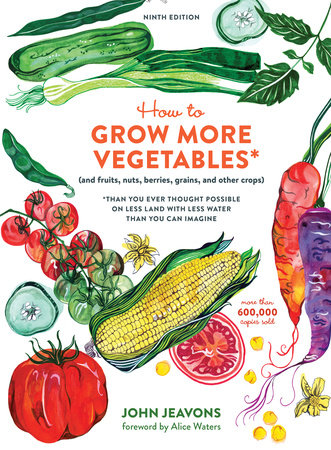Excerpt
How to Grow More Vegetables, Ninth Edition
Building Soil, Building the Future There is an exciting challenge ahead of us. How can we revitalize our extraordinary planet, ensuring life and health for the environment, the life-forms of myriad ecosystems, humankind, and future generations? The answer is as close to us as the food we consume each day. We can begin to create a better world from right where we are—in home gardens and mini-farms. Millions of people in more than 140 countries are already using Grow Biointensive sustainable mini-farming techniques to work toward this better world.
We “farm” as we eat. If we consume food that has been grown using methods that inadvertently deplete the soil in the growing process, we are responsible for depleting the soil. It is how we are “farming.” If, instead, we raise or request food grown in ways that heal the earth, then we are healing Earth and its soils. Our daily food choices make the difference. We can choose to sustain ourselves while increasing the planet’s vitality. In the process, we preserve resources, breathe cleaner air, enjoy good exercise, and eat pure food.
What are the dimensions of the challenge of raising food that sustains the soil? Current agricultural practices reportedly destroy approximately 6 pounds of soil for each 1 pound of food produced.1 United States croplands are losing topsoil about eighteen times faster than the soil formation rate. This loss is not sustainable. In fact, worldwide as little as 27 years’ worth of farmable soil remains.
Why is this happening? Conventional agricultural practices often deplete the soil eighteen to eighty times more rapidly than nature builds soil. This phenomenon happens when the humus (cured organic matter) in the soil is used up and not replaced, when cropping patterns are used that tend to deplete the soil’s structure, and when minerals are removed from the soil more rapidly than they are replaced. Even organic farming probably depletes the soil nine to sixty-seven times faster than nature builds it, by importing organic matter and minerals from other soils, which thereby becomes increasingly depleted. The planetary result is a net reduction in overall soil quality.
In contrast, the techniques used in Grow Biointensive sustainable mini-farming can build the soil up to sixty times faster than in nature.3
The overall goal of Grow Biointensive techniques, which distinguishes these techniques from Biointensive practices, is the miniaturization of food production in a closed system. Grow Biointensive features the use of the following eight techniques in a closed system that does not use any chemical substances. Almost two decades ago, Ecology Action coined the term “Grow Biointensive” to refer to this style of production.




